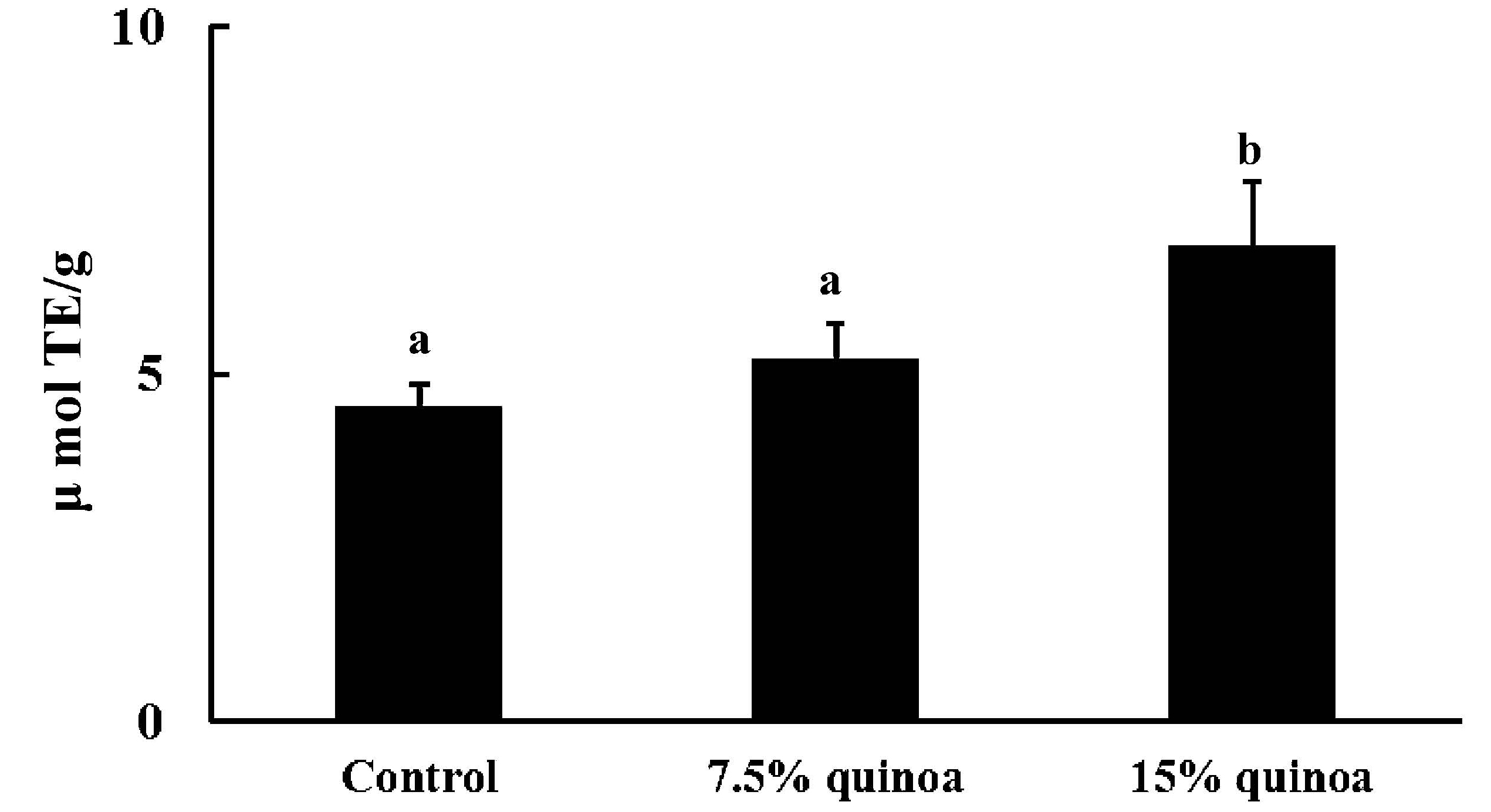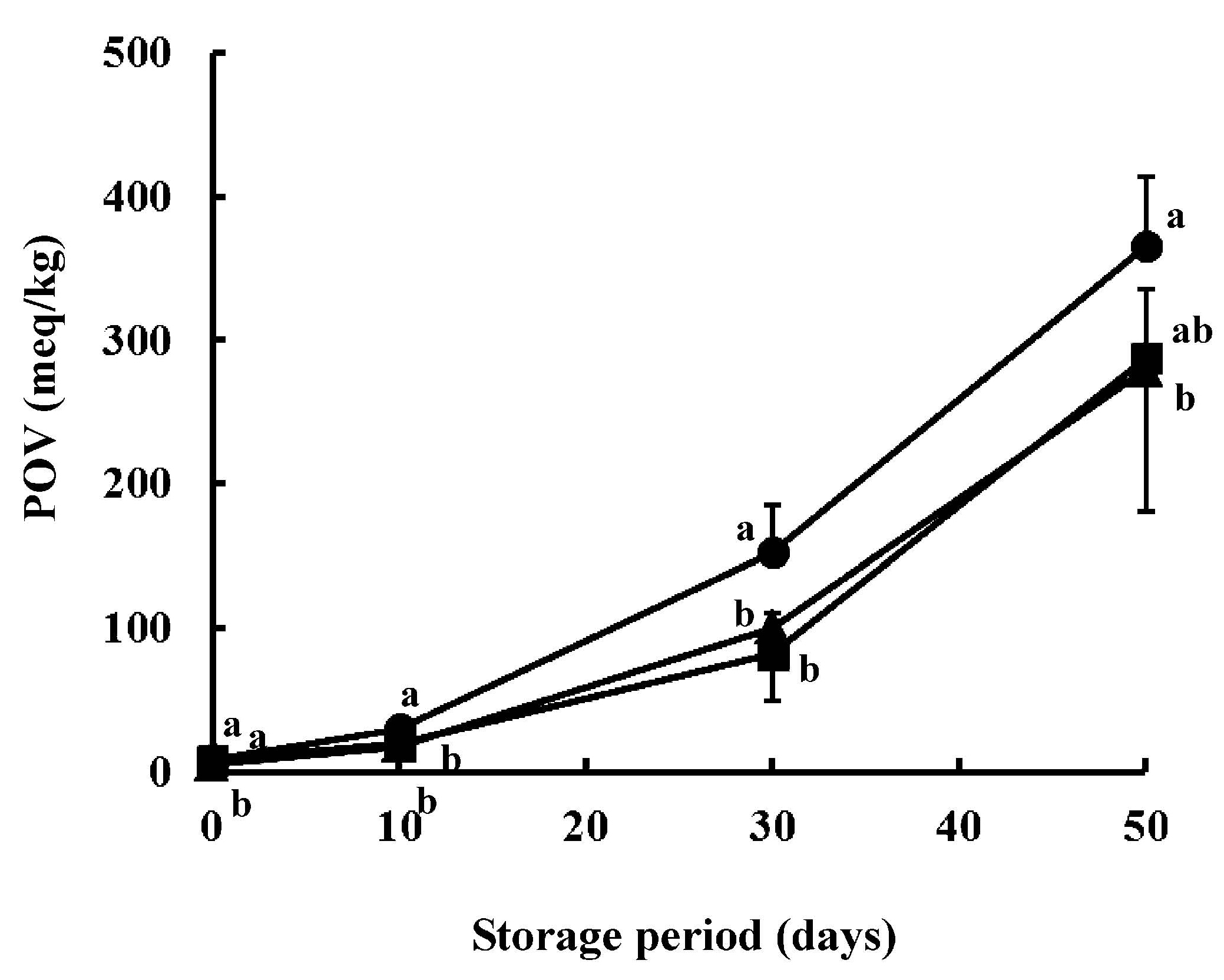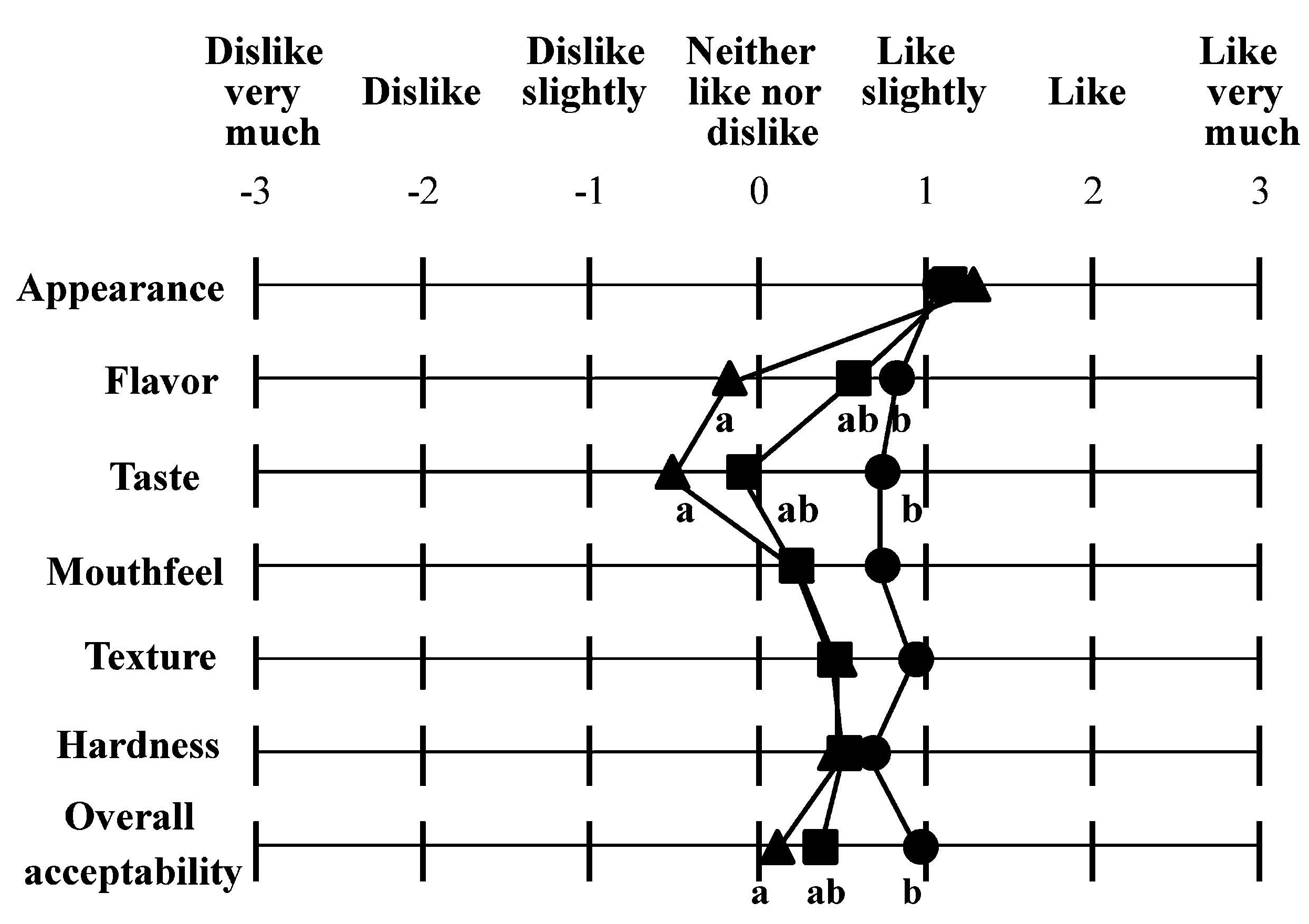2014 年 20 巻 3 号 p. 687-691
2014 年 20 巻 3 号 p. 687-691
Quinoa has strong antioxidant activity and a high amino acid score compared to common cereals such as rice and wheat. Therefore, cookies containing quinoa flour as a substitute for wheat flour were used to investigate the effects of quinoa on the oxidative stability and nutritional quality of the cookies. The antioxidant capacity of the cookies was increased by the addition of quinoa flour. As a result, the peroxide value of cookies containing quinoa was lower than that of cookies without quinoa after storage at room temperature. Additionally, quinoa substitution resulted in increased lysine content in the cookies. In sensory evaluation, the quinoa cookies were acceptable to the panelists. Quinoa is a functional and nutritious substitute for wheat flour.
Quinoa (Chenopodium quinoa Willd) is a pseudocereal native to the South American Andes. The grain is appreciated for its contribution to good nutrition. It contains a large proportion of high-quality protein because its lysine content is several times that of common cereals, resulting in a high amino acid score (Watanabe et al., 2003). Also, it has a high content of minerals, such as calcium, magnesium, iron and potassium, compared with other cereals (Galvez et al., 2010). In recent years, the functional properties of food have been of increasing interest, and the functional properties of quinoa, such as its suppressive effect on increased blood pressure (Ogawa et al., 2001), serum and liver cholesterol-lowering effects (Takao et al., 2005), antioxidant activity and allergenicity (Asao and Watanabe, 2010), have been investigated.
Oxidation of oils and fats contained in food during storage produces a complex mixture of volatiles that significantly affect the sensory properties of food, resulting in reduced nutritional quality, as well as harmful effects on human health. Quinoa flour can be used as a substitute for wheat flour in the production of food. Pasta and bread made with quinoa flour have been reported (Caperuto et al., 2001; Stikic eet al., 2003; Asao and Watanabe, 2010). It is proposed that the addition of quinoa flour may raise the antioxidant capacity and amino acid score in substituted food. However, the effects of quinoa on the oxidative stability and nutritional quality of food have not yet been reported.
In this study, cookies containing few ingredients yet high in oils and fats were made with quinoa flour to investigate its suppressive effect on the oxidation of oils and fats in food during storage, and the improvement in nutritional quality with the addition of quinoa flour.
Materials Quinoa, foxtail (Setaria italica L.), rice (Oryza sativa L.), Japanese millet (Echinochloa esculenta) and millet (Panicum miliaceum L.) grains were obtained from a local market and were powdered using a commercial electric mill. Purified lard without antioxidants was obtained from Miyoshi Oil & Fat Co., Ltd. (Tokyo, Japan), and used to investigate the contribution of quinoa to the oxidative stability of food.Other ingredients and reagents were purchased from local suppliers.
Cookie samples To evaluate the antioxidant capacity of quinoa flour, cookies were prepared using soft wheat flour, the purified lard and sugar at the ratio of 10:5:2 in weight (control cookie). Quinoa flour was substituted for 7.5% or 15% of wheat flour (7.5% quinoa cookie, 15% quinoa cookie, respectively). The ingredients were mixed to achieve a uniform mixture. Dough of 30-mm diameter and 6-mm thickness was prepared and baked in a commercial oven range according to the manufacturer’s protocol. Some of the baked cookies were packed into plastic bags and stored at room temperature under fluorescent light. Also, the baked cookies were subjected to amino acid analysis. The ingredients listed in Table 1 (control) were used for sensory evaluation.
Oxygen radical absorbance capacity (ORAC) assay Samples (100 mg) were suspended in 4 mL of acetone/water/acetic acid solution (70:29.5:0.5), mixed vigorously at room temperature for 5 min, and sonicated at 37°C for 15 min. The extracts were left at room temperature for 10 min and then centrifuged at 3500 rpm at 4°C for 15 min. The supernatants were subjected to ORAC analysis according to the procedure of Ou et al. (2001) using an SH-9000 Multi-grating microplate reader (Corona Electric Co. Ltd., Ibaraki, Japan).
Measurement of peroxide value (POV) Cookies were ground into powder after storage for a given period. Total lipids were extracted with diethyl ether (Isobe et al., 2004). The extract was evaporated in a rotary evaporator. The residue after the removal of organic solvent was used for POV analysis.
| Ingredients | |
|---|---|
| Flour | 100 g |
| Unsalted butter | 36 g |
| Baking powder | 2.5 g |
| Egga | 25 g |
| Sugar | 40 g |
| Vanilla essence | 0.1 g |
POV was determined by a standard iodometric titration procedure following the Japan Oil Chemist’s Society Official Method (Isobe et al., 2004). In brief, the sample was mixed with acetic acid-chloroform solution, then saturated potassium iodide solution. After standing in the dark, water and starch solution were added. The titration was run against a standard solution of sodium thiosulfate.
Amino acid analysis Cookies were hydrolyzed with 6N HCl containing 0.2% phenol at 105°C for 16 hr. The hydrolyzed specimens were dried and subjected to o-phthalaldehyde/chloroformic acid 9-fluorenylmethyl ester derivatization (Henderson et al., 2007). The derivatized samples were applied to a HPLC 1100 system (Agilent Technologies Inc., Wilmington, DE, USA) equipped with a Mightysil RP18 column (4.6 mm × 250 mm, 5 μm; Kanto Chemicals Co., Inc., Tokyo, Japan).
Sensory evaluation Cookies were evaluated for appearance, flavor, taste, mouth-feel, texture, hardness and overall acceptability. The evaluation was conducted by 35 university students aged from 21 to 23. A 7-point scale of palatability was used to evaluate the cookies. The panelists rated each sensory attribute between −3 point (dislike very much) and 3 point (like very much).
Statistical analysis Statistical analysis was performed using SPSS software (Version 18.0; SPSS Inc., Chicago, IL, USA). SPSS was used to perform one-way analysis of variance (ANOVA) and Tukey’s honestly significant difference post-hoc test at a 95% confidence level (p < 0.05).
Antioxidant capacity The antioxidant capacity of pseudocereals and cereals by the ORAC assay is shown in Fig. 1. The antioxidant capacity (19.8 μ mol TE/g) of quinoa flour was significantly higher than that of the others. This result was identical to those measured previously by the ferric thiocyanate and 1,1-diphenyl-2-picrylhydrazine (DPPH) methods (Asao and Watanabe, 2010). The antioxidant capacity of quinoa flour was high compared to wheat flour. Next, the antioxidant capacity of the cookies made with quinoa flour was determined using the ORAC assay. The TE value of the control cookie was 4.5 μ mol/g. In contrast, the TE values of 7.5% quinoa and 15% quinoa cookies were 5.2 and 6.9 μ mol/g, respectively (Fig. 2). The value was increased significantly by the substitution of quinoa flour for 15% of wheat flour. It was suggested that the addition of quinoa flour increased the antioxidant capacity of the cookies.

Antioxidant capacity of pseudocereals and cereals by ORAC assay. Values repreasent the mean ± standard deviation (SD) of four separate measurements. Bars marked with different letters indicate statistically significant differences (p < 0.05).

Antioxidant capacity of cookies made with quinoa flour by ORAC assay. Control, cookies not substituted; 7.5% quinoa, cookies substituted for 7.5% of wheat flour; 15% quinoa, cookies substituted for 15% of wheat flour. Values represent the mean ± SD of three separate measurements. Bars marked with different letters indicate statistically significant differences (p < 0.05).
Oxidative stability The oxidative stability of the quinoa cookies during storage was evaluated by measuring POV. Figure 3 shows the changes in POV of the quinoa cookies during storage. The initial POVs of the three types of cookies were 9.3, 10.2, 5.5 for control, 7.5% quinoa and 15% quinoa, respectively. The value of the 15% quinoa cookie was lower than those of the control and the 7.5% quinoa cookies. The POV increased with the storage period. However, the POV of the cookies containing quinoa flour was significantly lower than that of the control. After 10 days of storage, the value of the control was 30.6. In contrast, the values of 7.5% quinoa and 15% quinoa were 22.1 and 18.2, respectively. Quinoa flour suppressed the increase of POV. The values for the quinoa cookies were below 30 meq/kg, which is considered the limit of acceptability in fatty foods (i). It was demonstrated that lipid oxidation was reduced with the addition of quinoa flour.

Effect of quinoa flour on the POV of cookies stored at room temperature under fluorescent light. Values represent the mean ± SD of six separate measurements. Symbols with different letters indicate statistically significant differences (p < 0.05). ●, Control (cookies not substituted); ■, quinoa cookies substituted for 7.5% of wheat flour; ▲, quinoa cookies substituted for 15% of wheat flour.
Amino acid composition The proportion of essential amino acids contained in the three types of cookies is shown in Table 2. In relation to wheat flour, quinoa flour is particularly rich in lysine, which is the limiting amino acid in most cereals such as rice and wheat (Watanabe et al., 2003). The lysine content of the 15% quinoa cookie was 24/1000 amino acid residues. The threonine content was 34/1000. The values were significantly higher than those of the control. It was suggested that the essential amino acid levels in the cookies were enhanced by the addition of quinoa flour.
Sensory evaluation Figure 4 shows the sensory analysis of the quinoa cookies. There was no significant difference in sensory acceptability between the 7.5% quinoa and the control cookies. The 15% quinoa cookie was rated low on flavor, taste and overall acceptability attributes compared to the control, although the score on overall acceptability of 15% quinoa was above zero (neither like nor dislike).

Sensory evaluation of cookies made with quinoa flour. Values represent the mean of 35 panelists. Symbols with different letters indicate statistically significant differences (p < 0.05). ●, Control (cookies not substituted); ■, quinoa cookies substituted for 7.5% of wheat flour; ▲, quinoa cookies substituted for 15% of wheat flour.
| Control | 7.5% quinoa | 15% quinoa | |
|---|---|---|---|
| Ile | 43 ± 2 | 42 ± 2 | 46 ± 3 |
| Leu | 75 ± 2 | 74 ± 2 | 76 ± 4 |
| Lys | 18 ± 1a | 19 ± 3a | 24 ± 1b |
| Met | 16 ± 2 | 15 ± 1 | 15 ± 3 |
| Phe | 45 ± 4 | 45 ± 1 | 43 ± 3 |
| Thr | 30 ± 3a | 33 ± 2ab | 34 ± 1b |
| Trp | 6 ± 1 | 6 ± 1 | 7 ± 1 |
| Val | 52 ± 4 | 52 ± 3 | 51 ± 3 |
| His | 21 ± 4 | 19 ± 1 | 20 ± 1 |
Values represent the mean ± SD of four separate measurements. The values followed by different letters within a row indicate statistically significant differences (p < 0.05).
The oxidation of oils and fats in food is a major problem. It leads to rancidity and defective nutrition due to degradation products such as reactive oxygen species, which are harmful to human health (Sanders, 1983). Quinoa grains have strong antioxidant activity and a high amino acid score compared to common cereals such as rice and wheat (Watanabe et al., 2003). Quinoa flour is used as a substitute for wheat flour in the production of foods such as pasta and bread (Caperuto et al., 2001; Stikic et al., 2012). However, the effects of quinoa on the oxidative stability and the nutritional quality of the substituted foods have not yet been reported. Therefore, in this paper, the antioxidant capacity and amino acid composition of cookies made with quinoa flour were investigated. The antioxidant capacity of the cookies was increased by the addition of quinoa flour (Fig. 2). The TE value generated by the ORAC assay increased with the proportion of substituted quinoa flour. A discrepancy in the evaluation of antioxidant activity between the ORAC assay and conventional methods such as the DPPH assay has been raised (Ichimori, 2012; Kanno et al., 2013). However, the ORAC assay used in this work gave results identical to those using conventional methods (Asao and Watanabe, 2010) in the evaluation of the antioxidant capacity of pseudocereals and cereals (Fig. 1).
Quinoa flour increased the antioxidant capacity of the cookies (Fig. 2). The POV of the cookies was measured after storage, and the POV of cookies containing quinoa flour was lower than that of the control (Fig. 3). Quinoa contains a large quantity of lipid that is high in unsaturated fatty acids. However, the fatty acids are highly stable due to the presence of vitamin E, which acts as an antioxidant (Carrasco et al., 2003; Ng et al., 2007). The antioxidant activity against the lipids in quinoa was high compared with wheat (Asao and Watanabe, 2010). It was therefore suggested that quinoa contributes to the oxidative stability of food. On the other hand, quinoa is rich in lysine, which is found in low amounts in wheat. The substitution of quinoa flour for wheat flour increased the lysine content of the cookies (Table 2). Also, the threonine content was increased. Stikic et al. (2012) proposed that the incorporation of quinoa into wheat flour improved the lysine, methionine and histidine contents in bread. These results suggested that quinoa contributes to the improvement of essential amino acids levels in food.
In sensory evaluation, the 15% quinoa cookie was rated low on flavor, taste and overall acceptability compared to the control (not substituted). The scores on overall acceptability were 0.97, 0.37, 0.11 for control, 7.5% quinoa and 15% quinoa, respectively. Those values were above zero (neither like nor dislike). Therefore, it was suggested that the quinoa cookies were acceptable to the panelists, although the score was low. Also, quinoa is suggested to be appropriate for people allergic to wheat gluten (Asao and Watanabe, 2010). In conclusion, it is suggested that quinoa is a nutritious and functional substitute for wheat.
TE; trolox equivalents, SD; standard deviation, DPPH; 1,1-diphenyl-2-picrylhydrazine, POV; peroxide value, ORAC; oxygen radical absorbance capacity